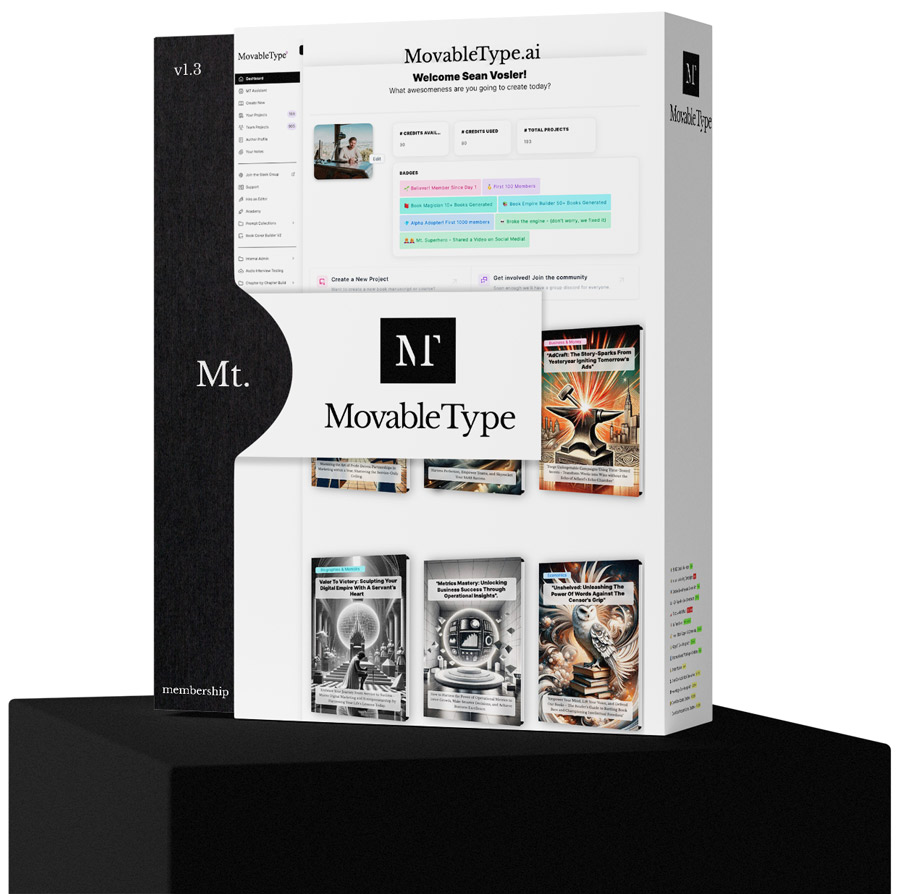- By: Rashad Marsh
How to Choose Winning Stocks without Being a Slave to Charts.
Your Book's Introduction - "The Preface"
Congratulations! Your book aced the “judge a book by its cover” test. But the journey doesn’t stop there – next up is the intro or “Preface.” At this phase, MovableType carefully engineers the preface to serve as an engaging “sales letter” designed to hook your readers, keep them engaged, and start the bond that will be nurtured between you and the reader moving forward.
Most writers are tempted to only talk about themselves in the introduction, but this is the opportune time to help your reader understand why THEY will benefit from reading your book.

Paige Turner
Your Project Guide
Preface
"You miss 100% of the shots you don't take." - Wayne Gretzky
Welcome to "The Chartless Investor: Simplifying Stock Market Analysis for Great Investment Choices." In this book, we aim to revolutionize the way you approach stock market analysis. We understand that analyzing charts can be overwhelming and time-consuming, especially for those who are new to the world of investing. That's why we have written this book - to simplify the process and empower you to make informed investment decisions without being a slave to charts.
Why did I decide to write this book? Because I was once in your shoes. I remember the frustration of spending countless hours studying complex charts, trying to decipher the ever-changing market trends. I found myself constantly glued to my computer screen, fearing that I might miss the perfect moment to buy or sell a stock. It was exhausting and took a toll on my personal life.
But then one day, I had a realization. What if there was a way to choose winning stocks without the need for constant chart monitoring? What if we could simplify stock market analysis and focus on the factors that truly matter? This thought sparked a journey of research, learning, and experimentation that ultimately led to the creation of this book.
As we worked on this project, we interviewed individuals who were facing the same frustrations as us. We heard stories of sleepless nights, strained relationships, and missed opportunities. We witnessed the toll that chart watching took on people's lives. It became clear to us that there was a need for a new approach to stock market analysis - an approach that would simplify the process and free investors from the chains of constant chart monitoring.
We want this book to serve as a beacon of hope for those who are seeking a better way to invest in the stock market. Our goal is to empower you with the knowledge and confidence to make great investment choices, without sacrificing your time and sanity. We believe that investing should be enjoyable and accessible to everyone, not just those with a background in finance.
Throughout the book, we will guide you through a step-by-step process that will demystify the stock market and help you identify great investment opportunities. We will explore fundamental analysis techniques, delve into the psychology of investing, and discuss the importance of diversification. By the end of the book, you will have a comprehensive understanding of how to choose winning stocks without the need for extensive chart watching.
Before I conclude this preface, I would like to express my deepest gratitude to all those who supported and contributed to the development of this book. From the mentors who guided us, to the friends and family who provided unwavering support, we could not have done this without you.
To you, the reader, thank you for choosing to invest your time and attention in this book. We know that your time is valuable, and we are committed to delivering value in return. We invite you to join us on this journey of simplifying stock market analysis and making great investment choices.
This book is written for individuals who have an interest in investing in the stock market but find the process of analyzing charts overwhelming and time-consuming. Whether you are a beginner or have some experience in the stock market, this book is designed to simplify the process and provide you with a straightforward approach to making informed investment decisions.
There are no prerequisites for understanding the material presented in this book. We have intentionally written this book in a way that is accessible to all readers, regardless of their level of knowledge or experience in investing.
Thank you once again for your purchase, and we encourage you to continue reading to discover the solutions you've been seeking. Together, let's reimagine stock market analysis and embrace a chartless approach to investing.
Your First Chapter
The first chapter is like the front porch of a book. It invites your readers in, gives them a glimpse of what’s inside, and warmingly invites them to step through the door. MovableType crafts the first chapter to directly address the central issue or problem the book revolves around. This approach ensures that the initial chapter delivers a clear and compelling solution, setting the tone for the book’s overarching theme.

Paige Turner
Your Project Guide
Chapter 1: Breaking Free from Chart Dependency
In the tranquility of late afternoon, when the sun hung low like an amber pendant above the horizon, George stood leaning against the railing of his modest backyard terrace. The wooden slats held the whispers of countless sunsets, bearing witness to his contemplative gaze that now swept across the boundless canvas of the sky. His neighbors' children played cacophonously in the distance, their laughter seeping through the air, mingling with the rhythmic chirping of crickets beginning their nightly chorus.
George's mind, however, trafficked not in the currency of suburban idylls but in stocks, tickers, and market fluctuations. He'd spent years poring over charts, seeking patterns like a miner sifting for glints of gold. And yet, the portfolio on his laptop screen, open and glaring like a gauntlet thrown down by an unseen adversary, told the tale of a bet gone awry. In his search for fortune, he'd become a servant to the curves and dips of line graphs.
Memories flickered—a seminar brimming with zealots of technical analysis, the energy intoxicating, promising riches through the alchemy of indicators and oscillators. Enthralled back then, mastery of this arcane knowledge had seemed like the Philosopher's Stone, capable of transmuting base metals into monetary gold.
But today's losses spoke of truths found too late. On the desk inside, a stack of financial newspapers rustled softly as a gust of wind bargained its way through a partially open window. The pages quivered, rich with narratives of corporate maneuvers and economic policies—a symphony of variables uncharted by his charts.
Distracted by the aroma of damp earth, a forewarning of the evening's imminent rain, George found his reflection in the glazed surface of a garden ornament, a sphere of polished stone. Within that curved mirror, he saw a version of himself, shaped by hope and shaded by doubt. The dynamics of fundamental analysis, once disregarded as the concern of scholars and executives, now seemed acutely relevant. Stocks, he realized, weren't just abstract points on a graph; they were shares of living, breathing enterprises.
The wind rustled again, stronger now, teasing the leaves of a maple tree into a dance of shadows and light. George watched as a solitary leaf broke free, embarking on an erratic journey--a whimsical contrast to the imagined precision of his technical patterns. Ruminating on the leaf's descent, unpredictable and yet graceful, he wondered if his investment strategy could learn from nature's caprice; could embracing a broader view of the market help him navigate its flux?
Was the squandering of time on unidimensional chart analysis merely a comforting illusion that glossed over the manifold heart of the marketplace?
Unshackling the Investor's Mind
Imagine a world where the rhythm of the markets is not dictated by the zigzag patterns of stock charts but understood through a deeper, more intuitive understanding of a company's heartbeat. The cold, hard lines of graphs often overshadow the vibrant narratives of companies and their potential for growth. It's time to consider removing the chart-colored glasses, to see the investment landscape with a newfound clarity that goes beyond the peaks and troughs of market graphs.
The idea that chart analysis reigns supreme in investment decisions is deeply ingrained in the minds of many. While riding the waves of volatile candlestick patterns can be exhilarating, it's akin to sailing the ocean while only watching the compass; one misses the panoramic view of the horizon, the wind in the sails, and the depth of the waters below. The first lesson we explore is a fundamental truth: chart analysis is not the solitary path to investment success. By opening our minds to this, we step into a broader world of information and insights that charts alone could never reveal.
Our second realization addresses the limitations of sole reliance on charts. Yes, they provide a snapshot of past performance and future speculation, but they are silent on the underlying narratives—the market whispers that fuel the fire of opportunity. In the world of stocks, this silence can be costly. Acknowledge the silence, and you'll begin to hear the true chorus of the markets: the fusion of numbers with vision, and data with strategy.
Moving beyond, we'll journey into the rich landscape of alternative approaches to stock market analysis. This path is not less traveled by accident; it requires a robust curiosity and a willingness to explore uncharted territories. Here, we find ourselves uncovering the multi-layered stories of companies, industries, and market trends that bring investments to life, stories neglected by a chart-centric viewpoint.
As we progress through the book, these themes will further unfold. In the following chapters, you will encounter the synergy of technical and fundamental analysis, a gateway to a more balanced and informed investment process. The simplicity approach will distill complex indicators into actionable wisdom. Moreover, we will delve deeply into the soil of investing basics to cultivate a healthy portfolio.
Empowering yourself with knowledge of financial statements will transform into interpreting the language of business. A comprehension of risk will be your North Star guiding investment decisions, and long-term thinking will become your telescope, helping you gaze beyond the ephemeral to the enduring value.
Imagine yourself as an explorer charting a new course—only this time, the maps are drawn not with lines and indicators but with experience, understanding, and a mindful approach to risk. This is the art of the chartless investor—someone who respects technical analysis but thrives on a richer, more holistic view of the investment world.
Navigating Investment Seas with Clearer Skies
The sky bristles with possibilities when one is not constantly scanning the horizon for the next technical indicator to flash a buy or sell signal. By fostering a continuous learning mindset, every day in the stock market becomes a lesson, every news item a potential insight. This ongoing education isn't a burden; it's an adventure, continually adding to your arsenal of informed choices.
In the denouement of our journey, the ultimate empowerment through simplification is achieved. It's about efficiency as much as efficacy, stripping away unnecessary complexity to reveal the clear truths of investing. The insights from these pages will imbue you with confidence, extending beyond the world of stocks into the realm of personal financial success.
As we waltz into this narrative together, let us approach the market with a fresh perspective—a gentle hand steering through a world often rife with aggressive chart-fueled convictions—and, in doing so, may we find investment choices that resonate not just with our wallets, but with our intellect and intuition.
Exploring Beyond the Chart
When it comes to investing, there's a widespread belief that the key to unlocking stock market success rests entirely within the squiggly lines of a stock chart. However, relying exclusively on chart analysis is akin to navigating a vast sea with just the stars above. While they provide guidance, what lies beneath the surface—the currents and the depth of the water—may tell a much more significant story. Charts offer a visual history of a stock's price movements, capturing the peaks and valleys of investor sentiment. But an exclusive focus on price trends can cause investors to overlook the robust undercurrents of a company's fundamental health.
To broaden your investing horizons, you need to recognize chart analysis as only one tool in a more extensive toolkit. Consider a farmer assessing his crops; he doesn't just look at the plants above ground. He tests the soil, evaluates weather patterns, and considers long-term sustainability to get the full picture. Successful investing operates similarly, requiring analysis that digs into the company's financial soil and climate—its balance sheets, income streams, market conditions, and growth prospects. These fundamental factors often dictate a stock's long-term trajectory far beyond what can be inferred from the fluctuations on a chart.
The stock market is not a game of chance. It's a field ripe with information if you know where to look. By integrating financial fundamental analysis, industry trends, and macroeconomic factors into your research, you can make more well-rounded investment decisions. This holistic approach may not provide the instant gratification of a chart's green and red arrows, but it offers a valuable perspective that helps mitigate risks associated with surface-level trading.
The essence of wise investing is recognizing that charts illuminate one part of the stock's story, but it's the fundamental analysis that fills in the rest of the narrative.
The Fundamentals of Freedom
Crafting the Compass: The Investor’s Guide
Let's craft your compass for navigating the stock market, moving beyond the reliance on charts to a more substantial strategy rooted in knowledge and insight.
Step 1: Define your investment goals. It's vital to understand what you're planting in your financial garden. Are you growing a sturdy oak for retirement or cultivating a colorful mix of annuals for short-term gains? This means reflecting on your aspirations, the timeline for your investments, and your appetite for risk. Defining what you aim to achieve guides every subsequent decision in your investing journey.
Step 2: Understand fundamental analysis. Roll up your sleeves and get ready to sift through the rich soil of a company's financial health. Fundamental analysis is like studying the roots of a plant, ensuring they are strong and can support growth. Dig into financial statements, engage with income statements, and mull over cash flow trends to get a true picture of a company’s vigor.
Step 3: Learn about key financial ratios. These ratios are like the nutrients for your investment plants—they must be balanced and indicative of good health. Discover the importance of ratios such as the price-to-earnings or debt-to-equity, and understand how these numbers can reflect the healthy bloom—or possible wilt—of your potential investment.
Step 4: Explore macroeconomic analysis. Stand back and observe the garden. Macroeconomic analysis allows you to understand the impact of sunlight and rainfall—economic indicators such as inflation rates and GDP growth—on your investment garden. This broad view can prevent a blight on your stocks should the economic weather turn tempestuous.
Step 5: Study industry analysis. Just as certain plants thrive in specific conditions, companies prosper in certain industry climates. By analyzing sector trends, competitive dynamics, and regulatory environments, you can better predict which businesses will flourish and which might struggle.
Step 6: Stay updated with company news and events. Like a diligent gardener who keeps an eye on emerging pests or diseases, stay informed about relevant corporate events. Earnings reports, executive changes, and product launches can all affect your investments' health and should influence your care strategy.
Step 7: Monitor stock valuations. Finally, ensure you’re not overpaying for your seeds. Assess whether a stock’s market price fairly represents its true value—compare it to fundamental worth through different valuation techniques, like discounted cash flow analysis, to ensure you're not investing in a bubble.
Could stepping away from chart dependency and embracing a broader analytical approach be the key to unlocking new realms of investment success?
Venturing into Alternative Analysis
Investing, at its core, is an exploration. Just as an astronomer uses a telescope to gaze at the stars, investors use various tools to examine the universe of stocks. But what if, instead of focusing the telescope solely on the patterns stars make—the charts of the finance world—one were to also study the physics that governs their movements?
Step 1: Define your investment goals. These are the coordinates you’ll use to navigate the investment landscape. Knowing where you want to go makes all the difference. Whether you're looking for fast growth or steady income, this foundational step illuminates the path forward.
Step 2: Understand fundamental analysis. Like a biologist looking through a microscope, delve into the lifeblood of companies. Here, the minutiae matter. Financial statements and executive decisions reveal the complex workings of an organization, much like cells and proteins demonstrate the health of a living organism.
Step 3: Learn about key financial ratios. These ratios are the mathematical representations of a company's health and potential—vital signs that tell you whether an investment is fit for your portfolio. Just as doctors rely on blood pressure and heart rate, investors use financial ratios to diagnose the financial well-being of a company.
Step 4: Explore macroeconomic analysis. Consider the ecosystem of finance. Like naturalists who interpret patterns within an ecological system, investors use macroeconomic analysis to predict how larger forces will affect the financial food chain.
Step 5: Study industry analysis. Some businesses thrive in specific environments. By studying the industry's terrain, you can anticipate growth, seeing which companies are poised to become the apex predators of their sector and which may fall prey to environmental shifts.
Step 6: Stay updated with company news and events. Knowledge is like nourishment for investment strategies; staying current with company activities keeps your strategy well-fed and your decisions sound.
Step 7: Monitor stock valuations. At the heart of alternative analysis is the comparison of a stock's market price to its intrinsic value. It’s about understanding the substance behind the symbol, ensuring the financial terra firma is solid beneath your investment's feet.
By weaving together these strands — the meticulous study of financials, the broader economic vista, the nuanced understanding of industries, and the pulse of company dynamics — you create a tapestry of knowledge that supports smart, informed investment choices.
The Power of Chartless Investing
Congratulations! You have just taken the first step towards chartless investing. By understanding that analyzing charts is not the only method for successful investing, you are empowering yourself to make well-informed investment decisions. You are breaking free from the dependency on charts and discovering alternative approaches to stock market analysis. But before we conclude this chapter, let's recap the key points we have covered.
We started by debunking the myth that analyzing charts is the only way to make profitable investment decisions. As we discussed, relying solely on charts overlooks fundamental factors that can significantly impact stock performance. A company's financial health, industry trends, and market conditions are just a few examples of the valuable information that can influence your investment decisions. Don't limit yourself to the narrow lens of chart analysis.
Next, we explored the limitations of solely relying on charts for investment decisions. While charts can provide valuable insights into historical price patterns, they often fail to capture the full picture. For instance, a stock may look attractive based on a chart's technical indicators, but its underlying fundamentals can tell a completely different story. Without considering these fundamental factors, you may be missing out on essential information that could make or break your investment. Don't let charts blind you to the bigger picture.
Finally, we delved into alternative approaches to stock market analysis. We discussed the importance of conducting thorough research, studying industry trends, and understanding the macroeconomic environment. By broadening your analysis beyond charts, you can gain a deeper understanding of the companies you are considering investing in. This comprehensive approach allows you to make well-rounded investment decisions based on a variety of factors. Expand your investment toolkit and unlock new opportunities.
So, what's next? In the upcoming chapters, we will dive deeper into these alternative approaches to stock market analysis. We will explore fundamental analysis, which examines a company's financial health and future prospects. We will also discuss macroeconomic analysis, which looks at broader economic trends and how they can impact the stock market. By incorporating these strategies into your investment approach, you will be well-equipped to choose winning stocks without being a slave to charts.
Now, I understand that breaking free from chart dependency may feel overwhelming at first. It's a new way of thinking and analyzing stocks. But trust me, by mastering these alternative approaches, you will unlock a world of investment opportunities. You will have the ability to make informed decisions based on a wide range of factors, giving you a competitive edge in the stock market.
So, are you ready to take your investment journey to the next level? Get ready to embrace the world of chartless investing and discover the exciting benefits that await you. Stay tuned for the next chapter, where we will explore the fascinating world of fundamental analysis. Together, we will simplify stock market analysis and empower you to make great investment choices. Get ready to become a chartless investor!


